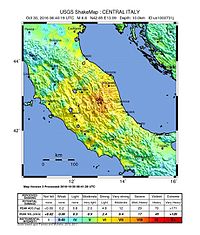
Photo from wikipedia
ABSTRACT This paper analyses the observational damage from post-earthquake investigations carried out on churches of the Marche Region struck by the 2016 Central Italy seismic sequence. Such seismic activity seriously… Click to show full abstract
ABSTRACT This paper analyses the observational damage from post-earthquake investigations carried out on churches of the Marche Region struck by the 2016 Central Italy seismic sequence. Such seismic activity seriously damaged many historical buildings and particularly churches, due to their intrinsic inability to develop an efficient box-like resisting mechanism. After the mainshocks, teams of structural engineers were involved in the assessment of damage of churches and in the evaluation of their usability. Collected data are processed in this work to give insight into the occurred damage and to evaluate the vulnerability of the religious buildings of the Region. To this purpose, an architectural background is firstly provided to allow for a classification of the sample, then, the most recurring damage mechanisms are identified, and a global damage index of each church is computed. The distribution of the damage over the Region is commented, as a function of the macro-seismic intensity and other important factors affecting the seismic response. Finally, the overall damage of the sample is compared to that estimated through empirical models available in the literature and comparisons with the results of previous studies are provided.
Journal Title: International Journal of Architectural Heritage
Year Published: 2019
Link to full text (if available)
Share on Social Media: Sign Up to like & get
recommendations!